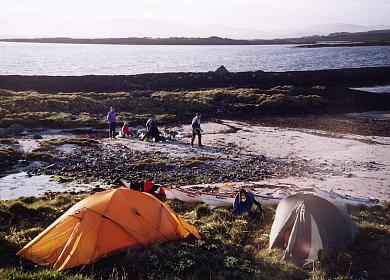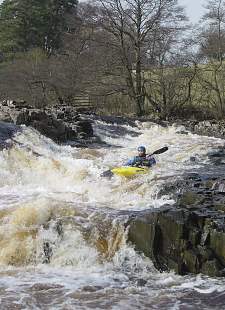
 Kayaking -
Kayaking -a long gestation

 Kayaking -
Kayaking -Andy started to paddle in 1976, on the River Cam in Cambridge, not a well-known white water venue. Fully occupied with the Caving Club at the time, I didn't have time to do another time-consuming activity to any significant level. But it was always "one of those things I'll get into eventually". An opportunity to paddle a river in Austria arose on a CUCC caving expedition, and I bought myself a Perception Pirouette in time for the next time I went out, paddling the river again (once) and playing a great deal on the lake. I managed to coach someone else to do his first roll, without ever managing one myself :-( I hardly knew any canoeists for years, but starting a family and having family membership of the Swaledale Outdoor Club provided an incentive to get going again - paddling seems a more likely activity to appeal to children than caving or serious fellwalking.
Having demonstrated that I was well-capable of survival whilst swimming near my kayak in white water, pool-training created a bit more ability (though thirteen swims in one trip down the Keswick Greta showed there was a way to go still). At the point of finally having learned to roll, along came foot-and-mouth to close down access to all the rivers, so sea kayaking became greatly appealing. And I was told that swimming was definitely not "the done thing" here :-)
 A long weekend at
Loch Sween and in the sound of Jura in absolutely perfect conditions
(written up in the SOC newsletter)
got me really hooked. This also looked like a good way to do multi-day
camping trips in uncrowded places without the children having to carry heavy
backpacks - something which definitely fitted with our ideas of a good
holiday. I came back from this trip so enthused that Mary decided there must
be something in this kayaking game, resulting in her going off on a
"Discover sea kayaking" course with Plas Menai.
A long weekend at
Loch Sween and in the sound of Jura in absolutely perfect conditions
(written up in the SOC newsletter)
got me really hooked. This also looked like a good way to do multi-day
camping trips in uncrowded places without the children having to carry heavy
backpacks - something which definitely fitted with our ideas of a good
holiday. I came back from this trip so enthused that Mary decided there must
be something in this kayaking game, resulting in her going off on a
"Discover sea kayaking" course with Plas Menai.
I soon bought my own first sea kayak (a North Shore Mistral), and became a regular participant in both days out and longer trips during the summer. Mary vacillated for ages over her own boat, as she is very light and had found it very hard paddling high volume boats into the wind. This limited the number of trips she got, as she had to borrow boats or go on courses. If we thought it was hard to find aboat to fit Mary at 45kg, it was going to be even harder to find one for my daughter Sarah, at under 20kg, who will probably be as light as Mary in another ten years or so as a young adult. Much research led me only to web pages about building kayaks - something about which I had my doubts. However, Nick Schade's book "The Strip-built Sea kayak" made the process sound just about within what I might tackle, so summer 2001 saw the start of my first kayak-building project, now named Geyrfugl. This 4.3m sea kayak is a 5/6ths scale version of Nick's Great Auk design and was completed in mid-February 2002.

Geyrfugl is too small for me, but proved to be moderately comfortable for Mary, and is an excellent fit for smaller people, though she is obviously a bit limited in rough conditions. But a wooden boat is such a nice thing that I had to have one.
I soon got to planning my next strip-built kayak. This one was (and eventually still is) going to be a 5.5m baidarka-style kayak (inspired by Laughing Loon's NorthStar, but independently evolved from the offsets of the Atka Island baidarka in the Hearst Museum, University of California at Berkeley), but unfortunately, my biggest heatable space isn't that long, so December 2002 saw the start of work on a different boat. To get some experience of different techniques, and try a few ideas out, this second boat has a stitch and glue hull with a strip deck - a hard-chined design with a rounded deck and very different from Geyrfugl. However, this Cormorant 466 is also scaled down from a published design, and is intended as a rock-hopping dayboat for me, or as a weekend boat for smaller members of the family. Launch date was ahead of my easter schedule, on April 9th 2003.
Mary finally chose a Low Volume version of the Romany from Nigel Dennis - a stable boat which gives her an excellent ability to enjoy big seas off the Scottish West Coast. No doubt I would enjoy these too, if I managed to take the North Shore boat, but so far, I have managed to take the smaller and rather tippy Cormorant whenever the sea has been rough, and the Mistral when it has turned out flat calm. Still, I now know I can roll :-)
We managed to come by a double very cheaply, and whilst this old McNulty Seaglass boat is a bit flat-bottomed for use on the sea and doesn't track well in a wind, it is great for non-technical trips with two children in the front - our first river descent with children on the Wye in 2002 was done in this.
I managed to hole my Pirouette on a weir on the Tees one very cold winter's
day, so I bought a Pyranha Acrobat 275, which proved rather more forgiving and
soon meant I was able to present some semblance of competance on grade 3 rivers.
By mid 2003 the lawn looked like this (with a 17' Mad River Revelation Open
Canoe not shown, and a Perception Sparc river kayak for Mary bought a few weeks
after this photo was taken). February 2004 saw a hole in my Acrobat, annoying as
I really get on well in this boat and it is only two years old. A repair may be
possible, but not before the next trip, so an ex-Demo Pyranha H2 zone
245 was hastily added to the stable, and a couple of rivers were enough to convince
me that I like that even better. A more convincingly sea-going double was added in
April 2004 - an Arctic Star 630 from Welho, delivered to my door from Helsinki for
the same number of Euros I'd expect to pay in pounds for a UK boat. That brings us
to a total of thirteen boats - of which our record is to transport all but one
(the Horizon) on/in our two cars to a Swaledale Outdoor Club come-and-try-it day.
(We had friends for New Year, at which point there were twenty boats in our storage
rack, which is getting pretty full !)

The Canadian is perhaps a better bet than the double kayak for river touring camping trips, and the Wye was again the venue for our first family descent in 2003. Both children did the Symonds Yat rapid solo in Michael's Masterlite kayak, too.

 Meanwhile, winter is the time for paddling rivers, and Mary has taken up
this aspect of kayaking too. Andy spent winter 2002/3 paddling white water most
Sundays. Indeed, in December 2002, on the third attempt, the Keswick Greta
went without a swim. This winter a limiting factor on this is Mary's "my
turn this weekend", which will undoubtedly become more frequent as she gets
into harder rivers. Sarah takes every opportunity to remind us that "it's not
fair" that the local Canoe Club does't take people under ten (especially when
she now has two kayaks of her own - Geyrfugl and a Dagger Blast for rivers,
which had its first outing on the Derwent into Derwent water in October 2003).
We seem to have infected the kayaking bug onto a number of the families of my old
university caving club friends too. Paddling sports seem to provide much better
opportunities for photography than caving, and I never really managed good
photos from my climbing or mountaineering. This has all now changed with my
first published photos in October 2003 - including the cover shot for the new
BCU "English White Water" guidebook (photo left, Tony Hammock on Salmon Leap
Falls on the Upper Tees). Other photos published in this guidebook are among
those in my new Whitewater Gallery page.
Meanwhile, winter is the time for paddling rivers, and Mary has taken up
this aspect of kayaking too. Andy spent winter 2002/3 paddling white water most
Sundays. Indeed, in December 2002, on the third attempt, the Keswick Greta
went without a swim. This winter a limiting factor on this is Mary's "my
turn this weekend", which will undoubtedly become more frequent as she gets
into harder rivers. Sarah takes every opportunity to remind us that "it's not
fair" that the local Canoe Club does't take people under ten (especially when
she now has two kayaks of her own - Geyrfugl and a Dagger Blast for rivers,
which had its first outing on the Derwent into Derwent water in October 2003).
We seem to have infected the kayaking bug onto a number of the families of my old
university caving club friends too. Paddling sports seem to provide much better
opportunities for photography than caving, and I never really managed good
photos from my climbing or mountaineering. This has all now changed with my
first published photos in October 2003 - including the cover shot for the new
BCU "English White Water" guidebook (photo left, Tony Hammock on Salmon Leap
Falls on the Upper Tees). Other photos published in this guidebook are among
those in my new Whitewater Gallery page.
To save searching through umpteen web sites for the weather info we needed for our various activities, I put together some useful charts and links into an outdoor weather page, which soon became big enough to split off the sea state page which might well be equally useful for other inshore water users. Unfortunately, weather info URLs seem to be among the most rapidly changing on the web, and I'm constantly finding that the charts and links on these pages get broken.